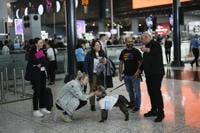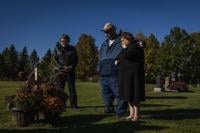CHICAGO (AP) — Buried at the edge of a Chicago Catholic cemetery are an elderly person’s remains marked only by a cement cylinder deep in the ground labeled with the numbers 04985. The person died in 2015 at a nursing home not remembering much, including their own name.
They went by Seven.
Now police specializing in missing people and cold cases have discovered Seven’s identity in one of the most unusual investigations the Cook County sheriff’s office has pursued and one that could change state law. Using post-mortem fingerprints, investigators identified Seven as 75-year-old Reba C. Bailey, an Illinois veteran missing since the 1970s.
The breakthrough is bringing closure to generations of relatives and friends. But whether they knew the name or the numeral, the investigation has unearthed more mysteries about how Reba, a Women’s Army Corps veteran raised in a large family, became homeless with no recollection, aside from wanting to be identified as a man called Seven.
Public records, interviews, newspapers and police work have offered some insight about the person with two lives, even with so much still unknown. Investigators say the next step is to honor them with a new gravestone and military honors.
“That’s a horrible circumstance that someone could die and no one knows who they are. That’s why we pursue these cases so strongly, out of dignity,” said Commander Jason Moran, who oversees the sheriff’s missing persons unit. “A person deserves a name.”
A CURIOUS COLD CASE
The case of Seven Doe — the name often appearing in official records — came to Cook County Sheriff Tom Dart last year.
His office has gained notoriety for work on cold cases, including identifying victims of and leading efforts to locate missing women statewide.
Seven’s case was unusual from the start.
The unidentified body belonged to an elderly woman who died of natural causes in an assisted living facility in Chicago. She was a ward of the state because she had no legal name or family she could remember.
“We never had anything like that before,” Dart said of Seven being unidentified both in life and death. “This one is different and it just kept getting more different.”
The cause of death was heart disease with diabetes and dementia as contributing factors, according to the Cook County medical examiner. Fingerprints taken at the time of death in November 2015 were run against police databases as is customary. There was no match for a criminal record.
She was buried at Mount Olivet Catholic Cemetery on the city’s Far South Side in a section for unclaimed people. The medical examiner marked it as the 4,985th case of the year.
Dart’s office usually takes up unsolved cases at least three years after they’ve gone cold. By then, it’s unlikely they’ll interfere with active investigations.
With foul play ruled out, investigators started by running Seven's fingerprints against more state and federal databases, including military records.
There was a match.
Investigators found 1961 Army records for Reba. They then tried to find relatives she was last in contact with in the 1970s, and identified five deceased siblings, most recently a sister who passed in 2007.
They also located more than half a dozen living nieces and nephews, a marriage record and evidence of traumatic events that would offer a window into her life.
“Human identification is a mix of science and circumstance,” Moran, who has been with the sheriff's department for more than two decades, said of his work. “It makes it very interesting to learn about who they were. The passage of time creates these difficulties. So we do the best we can to piece together who they were in life.”
FAMILY FOLKLORE AND FACTS
Most of Reba’s living relatives — nephews and nieces in Florida, Alabama and Illinois — never met her.
But they had heard of her.
Reba’s disappearance is part of family lore, something discussed at gatherings and reunions. So when Rick Bailey got a call from investigators about his long-lost aunt, he was “totally in shock.”
Bailey, a Florida funeral home director, is named after his father, Reba’s older brother Richard who died in 2000.
“My dad had searched for years to try and find his sister,” said Bailey, who’s 65 and believes Reba’s siblings would celebrate the news. “They would all be thrilled if they were here.”
He and other relatives have helped investigators learn more about Reba’s early years.
She was born in 1940 in Danville, about 140 miles (225 kilometers) south of Chicago, the daughter of a carpenter who often moved for work. Census records show multiple addresses for the family in Illinois and Alabama.
Tragedy hit Reba’s life at age 10 when she lost her mother in a car wreck that also left her, her father and her brother injured.
According to an October 1950 Chicago Tribune brief, Reba’s father backed up “to pick up a suitcase he saw beside the highway” when they were struck by another car. Edna Bailey, 46, died at a hospital.
Other records about Reba's youth are sparse. Most of the people who would have answers are dead.
Her photo doesn’t appear in the yearbooks of public or private Catholic schools in Danville. The building in Chicago’s Gold Coast where 1950 Census records show her family lived no longer exists. Her name doesn’t appear in a nearby high school’s yearbooks.
She worked stints as an elevator operator at a private club and as a sales clerk, according to military records which also list her hobbies as swimming, bowling, golf and photography.
About a decade after the accident, she joined the Women’s Army Corps, serving in Alabama, Texas and California. Military records show she was awarded a medal for good conduct and honorably discharged in 1962 “due to marriage.”
Around that time at age 21, she married John H. Bilberry, who was also in the Army, in California. No divorce records were found, but Bilberry remarried fourteen years later. His 1989 obituary said he served in Vietnam. The woman he remarried and two of his siblings have died.
After the military, few know what happened to Reba.
Different family stories have her popping up at a family visit in Arizona with her husband and often seeing an aunt in Chicago. Some relatives told police she took up alcohol and drugs and began dressing like a man.
Amanda Ingram, who would have been Reba’s great-niece, took up her grandfather’s search for his sister. As a family historian she keeps a meticulous family tree, with Census records and photos, on a family website.
Ingram has recently seen pictures of her late aunt and recognizes some Bailey family features, like a longer face shape. In one photo, Reba is wearing a black button down, her salt and pepper hair cropped short above her deep-set eyes. Prominent teeth peek out of a subtle smile.
Ingram hopes to find more answers.
“It is kind of like an onion,” she said. “You keep peeling it back and hopefully you find the story you really wanted to know.”
THE COOK WITH NO PAST
On a snowy day in the late 1970s, a person wearing a military-style jacket and aviator cap fastened under the chin was curled up on the porch of St. Francis Catholic Worker House.
The house on Chicago’s North Side was a place for homeless people and others who wanted to live in a community.
Resident Denise Plunkett was leaving for work at a hospital when she stumbled upon the person dressed in men's clothes. The encounter was so unusual that Plunkett, now 83, remembers it vividly.
The person spoke of themselves in the third person and didn’t answer personal questions about where they had come from. When asked their name, they would either say “Mr. Seven” or “He’s a number, not a name. His name is Seven.”
Nobody knew why.
Plunkett overlapped for a few years with Seven at the house and suspected there were possible mental health problems, but Seven declined help.
Seven quickly found a prominent role at the house.
He became the cook, whipping up beans and rice dishes and pasta casseroles each day. Word spread quickly in the neighborhood — home to several homeless advocacy organizations — that the meals at St. Francis were hearty. Crowds would line up outside the door for Seven's cooking, sometimes more than 100 people for a single dinner.
For more than two decades, Seven stayed at the white house located on a leafy residential block, sleeping in the men's quarters and smoking on the porch.
Residents there didn't learn much else about his life.
“I figured Seven would tell their story when they were ready to tell it,” said former house resident Sam Guardino. “I accepted him for who they were and who they presented as.”
When told about the recent identification of Reba Bailey and her early years, those who lived with Seven at the house had a similar response.
“It’s absolutely mind boggling,” said Plunkett.
A WARD OF THE STATE
While the time between Reba’s military service and the worker house are a mystery, the end of Seven’s life is well documented.
Seven left the worker house in 2003 after passing out in a hallway. Doctors later said it was diabetic shock. St. Francis was unable to provide the around-the-clock medical care that was required.
Since Seven did not have a legal name, Chicago police were called and launched an investigation. They filed a “found persons report,” documenting Seven’s memory loss and confusion.
They attempted to take fingerprints twice, but were unsuccessful, blaming both “disfigured” fingers and unreadable results, according to police reports. Chicago police, including the primary detective on the case, did not return messages from The Associated Press.
Police attempted to find an identity, circulating Seven’s photo to other Illinois law enforcement agencies. There was a false alarm with a person named “Skeven," who had died in a car crash.
A physical description of Seven noted very few teeth with one large front tooth, short white hair, blue eyes and light complexion.
Authorities did not account for gender identity, going only by biological sex, despite what Seven said. The police report noted “’Seven’ believes she is a male. A medical examination reveals that ‘Seven' is female."
The investigation into Seven’s identity was soon suspended.
“She has no last name or any recollection of her past prior to 27 years ago. There is no information with regard to relatives and she currently does not possess a Social Security number,” the police report concluded.
With no family stepping forward and no identity, Seven became a ward of the state and was placed at a nursing home along Lake Michigan.
The unusual position, as an unidentified adult ward of the state, was chronicled in a 2012 Chicago Tribune where Seven was referred to as a woman. In it, Seven was described as a “lifelong Cubs fan” with “fleeting childhood memories of visiting the Indiana Dunes,” a national park outside Chicago.
Three years later, Seven died.
Family members who have learned more about their great aunt's life in later years have found comfort.
“We know she was cared for,” Ingram said. “That is the best that my grandfather could have ever asked for.”
CHANGING STATE LAW
The cold case could prompt a change in Illinois law.
The Cook County sheriff’s office wants to amend the state's Missing Persons Identification Act to require postmortem fingerprints be checked against all available state and federal databases, not just police. The idea is a fuller search at the time of death could help identify people sooner. Dart's office is drafting the legislation, which state lawmakers could take up this year.
With unidentified homicide victims, an earlier match could help with investigations that are already challenged by the passage of time.
“It's frustrating,” Moran said. “As every day goes by, sometimes you lose evidence, sometimes you lose family."
Such a change could also bring families closure sooner. Moran said families of missing people live in “a cruel limbo” not knowing if their loved one is alive or dead.
In Reba’s case, relatives could have held a memorial service and buried her where they wanted eight years ago.
“Her family would have known earlier,” Moran said.
MYSTERIES LINGER
Cook County investigators have updated the entry for Seven Doe in a federal database of missing people, adding Reba Bailey’s name and photo.
But many other parts of the case remain mysterious.
“We don’t know what she was thinking or feeling or what her wishes were,” Moran said.
Relatives wonder whether Reba had children, what happened with the marriage and about their aunt’s gender identity.
They don’t know what prompted her to fall out of contact. Family stories suggest it was a dispute with her father, but there are different versions about whether it was over her decision to join the military, her sexual orientation or something else.
Investigators have also tried to explain Reba’s memory loss. They’ve floated theories about brain damage from the car accident that killed her mother or her military service.
Reba served at Fort Ord in California, Army base, and Fort McClellan in Alabama, once the home of chemical weapons training where the federal government has to toxins.
No one has been able to figure out the meaning behind the name Seven.
Investigators hypothesized that it was possibly related to military service or birth order.
Reba was the youngest of six, including two siblings who died as children. But her great-niece recently found matches on for previously unknown relatives, including one who could be another Bailey sibling. Ingram said her grandfather sometimes mentioned another baby in the family.
Public records in Illinois couldn’t verify the existence of another birth; neither could police.
But if there was another sibling, Reba would have been child number seven.
“It does bring closure to a lot of mysteries that we have had,” Ingram said about knowing her aunt’s identity. “It opens a lot of other doors.”
HONORING A LIFE
On a recent fall day, Moran walked to a back corner of Mount Olivet on Chicago’s Far South Side to the section of the cemetery for unclaimed people. The cement cylinders sit nearly submerged in the ground, sometimes leaving them covered in dirt and debris. The medical examiner marks them with the office initials “ME”, the year and the case number.
Moran reached down gently brushed leaves off 04985. By spring, he hopes it’ll be replaced. The sheriff’s office is pursuing a new gravestone, military marker and a memorial ceremony for Reba's life.
Family members had considered moving the remains closer to other family buried in either Florida or Alabama. One brother, Richard an Air Force veteran, is buried at the Barrancas ��ɫtv Cemetery in Florida. But moving the body would be expensive and complicated.
“We decided as a family not to disturb her,” Rick Bailey said. “At least we know where she is now.”
___
AP researcher Jennifer Farrar in New York contributed to this report.
__
The Cook County sheriff's missing person project:










































